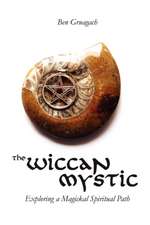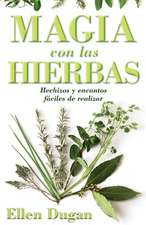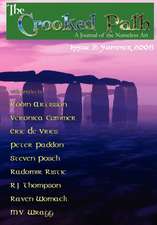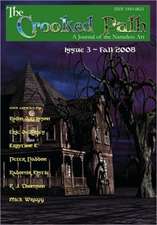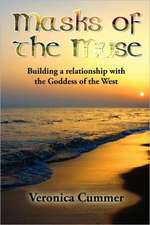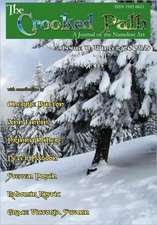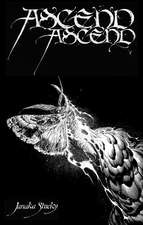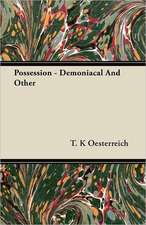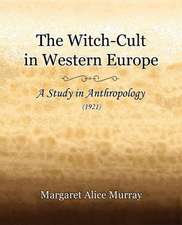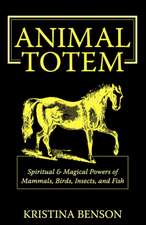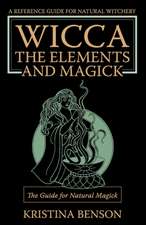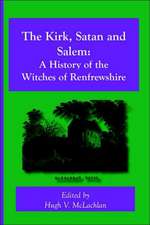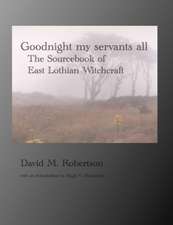Waking the Witch: Reflections on Women, Magic, and Power: Witchcraft Bestseller
Autor Pam Grossmanen Limba Engleză Hardback – 10 iul 2019
A whip-smart and illuminating exploration of the world’s fascination with witches from podcast host and practicing witch Pam Grossman (The Witch Wave), who delves deeply into why witches have intrigued us for centuries and why they’re more relevant now than ever.
When you think of a witch, what do you picture? Pointy black hat, maybe a broomstick. But witches in various guises have been with us for millennia. In Waking the Witch, Pam Grossman explores the cultural and historical impact of the world’s most magical icon. From the idea of the femme fatale in league with the devil in early modern Europe and Salem, to the bewitching pop culture archetypes in Buffy the Vampire Slayer, Sabrina the Teenage Witch, and Harry Potter; from the spooky ladies in fairy tales and horror films to the rise of feminist covens and contemporary witchcraft, witches reflect the power and potential of women.
In this fascinating read that is part cultural analysis, part memoir, Pam opens up about her own journey on the path to witchcraft, and how her personal embrace of the witch helped her find strength, self-empowerment, and a deeper purpose.
A comprehensive meditation on one of the most mysterious and captivating figures of all time, Waking the Witch celebrates witches past, present, and future, and reveals the critical role they have played—and will continue to play—in shaping the world as we know it.
| Toate formatele și edițiile | Preț | Express |
|---|---|---|
| Paperback (1) | 51.07 lei 24-36 zile | |
| Gallery Books – 12 noi 2020 | 51.07 lei 24-36 zile | |
| Hardback (1) | 65.09 lei 3-5 săpt. | +14.87 lei 4-10 zile |
| Gallery Books – 10 iul 2019 | 65.09 lei 3-5 săpt. | +14.87 lei 4-10 zile |
Preț: 65.09 lei
Nou
12.46€ • 12.96$ • 10.28£
Carte disponibilă
Livrare economică 25 martie-08 aprilie
Livrare express 08-14 martie pentru 24.86 lei
Specificații
ISBN-10: 1982100702
Pagini: 304
Dimensiuni: 135 x 210 x 25 mm
Greutate: 0.36 kg
Editura: Gallery Books
Colecția Gallery Books
Seria Witchcraft Bestseller
Notă biografică
Pam Grossman is the creator and host of The Witch Wave podcast and the author of What is a Witch. Her writing has appeared in such outlets as The New York Times, The Atlantic, Time, Ms., and her occulture blog, Phantasmaphile. She is cofounder of the Occult Humanities Conference at NYU, and her art exhibitions and magical projects have been featured in such publications as Artforum, Art in America, and The New Yorker. She lives in Brooklyn with her husband and their feline familiar. You can find her at PamGrossman.com and @Phantasmaphile.
Recenzii
"[A] beguiling exploration of witches across history, myth, art and pop culture. Part history, part memoir, part effervescent feminist manifesto, the book takes readers on an exhilarating ride through witchy archetypes...The book fizzes with an infectious energy and paints a compelling picture of witches in all their shape-shifting complexity."
“Pam Grossman has written a flowing history that I scarfed down like an eclair. She reminds us that witches are not monsters so much as possibilities. The archetypal, swirling symbol of ‘Witch’ is a guide to remind us that we are allowed to act on our desires AND congratulate ourselves for choosing to. I hope this book makes everyone who reads it ask themselves ‘What do I deny myself and why?’ I started this book all in, but when I read the sentence ‘Show me your witches, and I’ll show you your feelings about women,’ I knew I was done for."
“A fun, informative glimpse of witchcraft... Waking the Witch reflects Grossman’s ability to cast her spell with memoir, storytelling, journalism, and history. Feminists will appreciate Grossman’s in-depth, woman-focused history and analysis. A must-add for public and academic collections.”
“A fun study… Feminist readers will be pleased by Grossman’s deconstruction of witch clichés.”
“Pam Grossman already hosts the inspiring podcast 'The Witch Wave,' and has translated her knowledge of witchhood into relatable, inspiring memoir pages. From personal experience to intriguing knowledge, Grossman breaks the stigmas of what the entertainment industry has made witches out to be, and speaks of the spiritual journey she's discovered within the title.”
“Deftly illuminating the past while beckoning us towards the future, Waking the Witch has all the makings of a feminist classic. Wise, relatable and real, Pam Grossman is the witch we need for our times."
"A masterful and moving meditation on female power and persecution, Waking the Witch deftly lifts the veil between fact and fiction, indulging joyfully and critically in the distortions and delectations that have surrounded magical women for millennia. Pam Grossman is a beacon in the world of contemporary witchcraft and neo-paganism, and this comprehensive work grounded in scholarship and cultural criticism is brought to life through intimate stories from her own life and spiritual practice. Waking the Witch is an artful gateway into a history that is both profoundly and painfully relevant today. Whether you’re intrigued by or deeply committed to the who, what, when, where, and why of the witch, this book is for you."
“Conjuring a contemporary perspective on the witch in both fact and fiction, Pam Grossman lays the breadcrumbs, connecting the corners from devilish cohort to bubblegum hero and all the identities between. Sublime, witty and often deeply personal, she draws you into her circle, that of the Divine Feminine and her Earthly practitioners.”
"My heart thrills in gratitude for this book and for everything Pam Grossman contributes to the study, practice, and pleasure of witchcraft. With rare insight and flair for nuance, Waking the Witch explores ambiguous territories few writers dare to tread. As only a practicing witch could do, Grossman engages the witch archetype even in the liminal spaces where she becomes most difficult. Witches are myths, are monsters, are sisters and sirens, and witches are REAL. Fearless and brilliant, this book is a must-read for anyone interested in spirituality with intelligence."
"Elegant, grounded, and warm, Pam Grossman is the perfect guide for initiation into the mysteries of the witch. Pam conjures witches from their many dwellings in history, feminism, and pop culture with care and play. Swaying among this coven is Pam herself, embodying the witch in a tender spiritual memoir woven through the cultural sense-making. Waking the Witch goes beyond edifying and enjoyable, casting a spell that might wake your own connection to magic, beauty, and meaning."
“Students and scholars will savor Waking the Witch’s historicism—which is brilliant—and practitioners will thrill to its understanding and inspiration. In a world of boundless choices, this is one of the singularly finest works for understanding modern witchcraft. It will never leave my bookshelf.”
"Pam Grossman’s brilliant examination of the witch in history, literature, politics, and contemporary culture provides much-needed insight into our convoluted and deeply held beliefs about feminine power. With wit and wisdom, scholarship and sass, Grossman reveals why witches both frighten and fascinate us, and why witchcraft’s popularity is growing today as women reclaim their birthright after centuries of infamy. Waking the Witch is a must-read if you want to understand gender politics today or seek to enjoy a more fulfilling relationship with the women in your life. Prepare to be pleasantly awakened as you meet your own inner witch, reconnect with her origins, and see how honoring her can transform your world."
“The wonderful Pam Grossman takes us on a whirlwind tour of witches in history, literature, and the cinematic and visual arts, serving up much food for thought along the way. Her exploration of alchemical artists Leonora Carrington and Remedios Varo is no less than brilliant. But my own favorite parts of Waking the Witch are Pam’s generously-shared descriptions of her own personal journey to magic and power. Recommended!”
"With this brilliant offering, Pam untangles the web of the witch and invites us to explore all the aspects of ourselves that linger in the shadows. Waking the Witch weaves us into the mystery of the witch, reminding us of her familiarity through stories, symbols and the subconscious, inviting us into her world with a wink and the promise of apple. Pam reminds us of the resilience of the witch, of all we have to learn from her, and of what she has to offer us. Through both her words and practice, Pam exemplifies that now more than ever, we need to wake the witch in her magick. This book is an indispensable addition to anyone’s altar or bookshelf, witch or not."
“A must-read for anyone interested in feminism or witchcraft… Part memoir and part historical survey, this book is jam-packed full of information, yet a surprisingly quick read. Get ready to be inspired; this witchy offering might make you want to start casting spells yourself!”
“Powerful… No one–no one!– has the ability to grab my attention and my imagination quite that way that Pam does… A beautiful, brilliant, biblio-treat, I found this is not so much a casual book for the nightstand so much as a magical grimoire/memoir for my altar. But whether your interest lies in witches and witchcraft or feminism, culture, and gender, I believe you’ll find yourself too ensnared in its spell to leave it lay long in either place.”
Extras
![]() Introduction
Introduction ![]()
Witches have always walked among us, populating societies and storyscapes across the globe for thousands of years. From Circe to Hermione, from Morgan le Fay to Marie Laveau, the witch has long existed in the tales we tell about ladies with strange powers that can harm or heal. And although people of all genders have been considered witches, it is a word that is now usually associated with women.
Throughout most of history, she has been someone to fear, an uncanny Other who threatens our safety or manipulates reality for her own mercurial purposes. She’s a pariah, a persona non grata, a bogeywoman to defeat and discard. Though she has often been deemed a destructive entity, in actuality a witchy woman has historically been far more susceptible to attack than an inflictor of violence herself. As with other “terrifying” outsiders, she occupies a paradoxical role in cultural consciousness as both vicious aggressor and vulnerable prey.
Over the past 150 years or so, however, the witch has done another magic trick, by turning from a fright into a figure of inspiration. She is now as likely to be the heroine of your favorite TV show as she is its villain. She might show up in the form of your Wiccan coworker, or the beloved musician who gives off a sorceress vibe in videos or onstage.
There is also a chance that she is you, and that “witch” is an identity you have taken upon yourself for any number of reasons—heartfelt or flippant, public or private.
Today, more women than ever are choosing the way of the witch, whether literally or symbolically. They’re floating down catwalks and sidewalks in gauzy black clothing and adorning themselves with Pinterest-worthy pentagrams and crystals. They’re filling up movie theaters to watch witchy films, and gathering in back rooms and backyards to do rituals, consult tarot cards, and set life-altering intentions. They’re marching in the streets with HEX THE PATRIARCHY placards and casting spells each month to try to constrain the commander in chief. Year after year, articles keep proclaiming, “It’s the Season of the Witch!” as journalists try to wrap their heads around the mushrooming witch “trend.”
And all of this begs the question: Why?
Why do witches matter? Why are they seemingly everywhere right now? What, exactly, are they? (And why the hell won’t they go away?)
I get asked such things over and over, and you would think that after a lifetime of studying and writing about witches, as well as hosting a witch-themed podcast and being a practitioner of witchcraft myself, my answers would be succinct.
In fact, I find that the more I work with the witch, the more complex she becomes. Hers is a slippery spirit: try to pin her down, and she’ll only recede further into the deep, dark wood.
I do know this for sure though: show me your witches, and I’ll show you your feelings about women. The fact that the resurgence of feminism and the popularity of the witch are ascending at the same time is no coincidence: the two are reflections of each other.
That said, this current Witch Wave is nothing new. I was a teen in the 1990s, the decade that brought us such pop-occulture as Buffy the Vampire Slayer, Charmed, and The Craft, not to mention riot grrrls and third-wave feminists who taught me that female power could come in a variety of colors and sexualities. I learned that women could lead a revolution while wearing lipstick and combat boots—and sometimes even a cloak.
But my own witchly awakening came at an even earlier age.
Morganville, New Jersey, where I was raised, was a solidly suburban town, but it retained enough natural land features back then to still feel a little bit scruffy in spots. We had a small patch of woods in our backyard that abutted a horse farm, and the two were separated by a wisp of running water that we could cross via a plank of wood. When we were little, my older sister, Emily, and I would sometimes venture to the other side, where we could feed the horses (an act that still scares me to this day) and pick fistfuls of clover. But the majority of our time was spent on our side of the stream, threading ourselves through the thicket of trees that served as our personal forest. In one corner of the yard, a giant puddle would form whenever it rained, surrounded by a border of ferns. We called this spot our Magical Place. That it would vanish and then reappear only added to its mystery. It was a portal to the unknown.
These woods are where I first remember doing magic—entering that state of deep play where imaginative action becomes reality. I would spend hours out there, creating rituals with rocks and sticks, drawing secret symbols in the dirt, losing all track of time. It was a space that felt holy and wild, yet still strangely safe.
As we age, we’re supposed to stop filling our heads with such “nonsense.” Unicorns are to be traded in for Barbie dolls (though both are mythical creatures, to be sure). We lose our tooth fairies, walk away from our wizards. Dragons get slain on the altar of youth.
Most kids grow out of their “magic phase.” I grew further into mine.
My grandma Trudy was a librarian at the West Long Branch Library, which meant I got to spend many an afternoon lurking between the 001.9 and 135 Dewey decimal–sections, reading about Bigfoot and dream interpretation and Nostradamus. I spent countless hours in my room, learning about witches and goddesses, and I loved anything by authors like George MacDonald, Roald Dahl, and Michael Ende—writers fluent in the language of enchantment. Books were my broomstick. They allowed me to fly to other realms where anything was possible.
My very favorite book was Wise Child by Monica Furlong, a story about a young girl who gets taken in by Juniper, a kind and beautiful witch who lives at the top of a hill in the Scottish countryside. Juniper is feared by the local townsfolk because she doesn’t practice their religion and because she is a woman who lives on her own. She teaches Wise Child the ways of natural medicine and magic, and shows her the kind of love that a mother might. The villagers come to them in secret whenever they are in need of healing, but in public, Juniper and Wise Child are shunned. Witches, I learned from the book, are complicated creatures, sources of great comfort and great terror. And no matter how good a witch might be, she would often become the target of misunderstanding at best and persecution at worst.
The witch is always at risk. Nevertheless, she persists.
Though fictional witches were my first guides, I soon discovered that magic was something real people could do. I started frequenting new age shops and experimenting with mass-market paperback spell books from the mall. I was raised Jewish but found myself attracted to belief systems that felt more individualized and mystical and that fully honored the feminine. Eventually I found my way to modern Paganism, a self-directed spiritual path that sustains me to this day. I’m not unique in this trajectory of pivoting away from organized religion and toward something more personal: as of September 2017, more than a quarter of US adults—27 percent—now say that they think of themselves as spiritual but not religious, according to Pew Research Center.
Now, I identify both as a witch and with the archetype of the witch overall, and I use the term fluidly. At any given time, I might use the word witch to signify my spiritual beliefs, my supernatural interests, or my role as an unapologetically complex, dynamic female in a world that prefers its women to be smiling and still. I use it with equal parts sincerity and salt: with a bow to a rich and often painful history of worldwide witchcraft, and a wink to other members of our not-so-secret society of people who fight from the fringes for the liberty to be our weirdest and most wondrous selves. Magic is made in the margins.
To be clear: you don’t have to practice witchcraft or any other alternative form of spirituality to awaken your own inner witch. You may feel attracted to her symbolism, her style, or her stories but are not about to rush out to buy a cauldron or go sing songs to the sky. Maybe you’re more of a nasty woman than a devotee of the Goddess. That’s perfectly fine: the witch belongs to you too.
I remain more convinced than ever that the concept of the witch endures because she transcends literalism and because she has so many dark and sparkling things to teach us. Many people get fixated on the “truth” of the witch, and numerous fine history books attempt to tackle the topic from the angle of so-called factuality. Did people actually believe in magic? They most certainly did and still do. Were the thousands of victims who were killed in the sixteenth- and seventeenth-century witch hunts actually witches themselves? Most likely not. Are witches real? Why, yes, you’re reading the words of one. All of these things are true.
But whether or not there were actually women and men who practiced witchcraft in Rome or Lancashire or Salem, say, is less interesting to me than the fact that the idea of witches has remained so evocative and influential and so, well, bewitching in the first place.
In other words, the fact and the fiction of the witch are inextricably linked. Each informs the other and always has. And so, it’s from this fuzzy, fabulist focal point that I regard her in the following chapters—and in general. I’m fascinated by how one archetype can encompass so many different facets. The witch is a notorious shape-shifter, and she comes in many guises:
A hag in a pointy hat, cackling madly as she boils a pot of bones.
A scarlet-lipped seductress slipping a potion into the drink of her unsuspecting paramour.
A cross-dressing French revolutionary who hears the voices of angels and saints.
A perfectly coiffed suburban housewife, twitching her nose to change her circumstances at will, despite her husband’s protests.
A woman dancing in New York City’s Central Park with her coven to mark the change of the seasons or a new lunar phase.
The witch has a green face and a fleet of flying monkeys.
She wears scarves and leather and lace.
She lives in Africa; on the island of Aeaea; in a tower; in a chicken-leg hut; in Peoria, Illinois.
She lurks in the forests of fairy tales, in the gilded frames of paintings, in the plotlines of sitcoms and YA novels, and between the bars of ghostly blues songs.
She is solitary.
She comes in threes.
She’s a member of a coven.
Sometimes she’s a he.
She is stunning, she is hideous, she is insidious, she is ubiquitous.
She is our downfall. She is our deliverance.
Our witches say as much about us as they do about anything else—for better and for worse.
More than anything, though, the witch is a shining and shadowy symbol of female power and a force for subverting the status quo. No matter what form she takes, she remains an electric source of magical agitation that we can all plug into whenever we need a high-voltage charge.
She is also a vessel that contains our conflicting feelings about female power: our fear of it, our desire for it, and our hope that it can—and will—grow stronger, despite the flames that are thrown at it.
Whether the witch is depicted as villainous or valorous, she is always a figure of freedom—both its loss and its gain. She is perhaps the only female archetype who is an independent operator. Virgins, whores, daughters, mothers, wives—each of these is defined by whom she is sleeping with or not, the care that she is giving or that is given to her, or some sort of symbiotic debt that she must eventually pay.
The witch owes nothing. That is what makes her dangerous. And that is what makes her divine.
Witches have power on their own terms. They have agency. They create. They praise. They commune with the spiritual realm, freely and free of any mediator.
They metamorphose, and they make things happen. They are change agents whose primary purpose is to transform the world as it is into the world they would like it to be.
This is also why being called a witch and calling oneself a witch are usually two vastly different experiences. In the first case, it’s often an act of degradation, an attack against a perceived threat. The second is an act of reclamation, an expression of autonomy and pride. Both of these aspects of the archetype are important to keep in mind. They may seem like contradictions, but there is much to glean from their interplay.
The witch is the ultimate feminist icon because she is a fully rounded symbol of female oppression and liberation. She shows us how to tap into our own might and magic, despite the many who try to strip us of our power.
We need her now more than ever.
What follows, then, is an exploration of the archetype of the witch: meditations on her various aspects and associations, questions she’s conjured throughout my life, and lessons I’ve learned from walking the witch’s path.
And it is a permission slip for you too to identify with her, should you feel yourself falling under her spell.
Look around. Look within.
The witch is waking up.
Descriere
From the podcast host of The Witch Wave and practicing witch Pam Grossman comes an exploration of the world’s fascination with witches.


